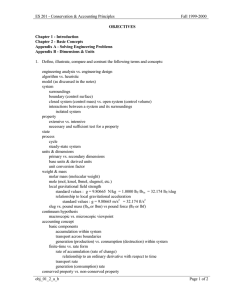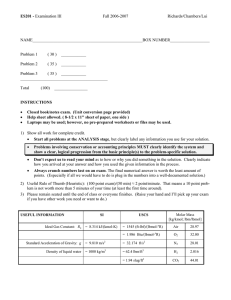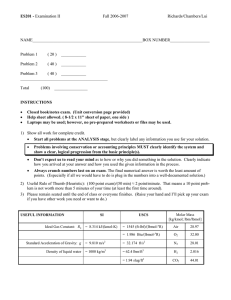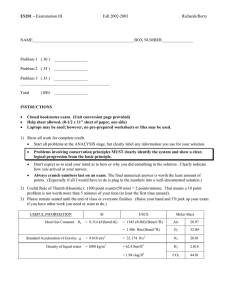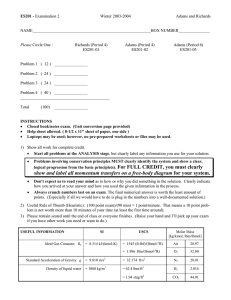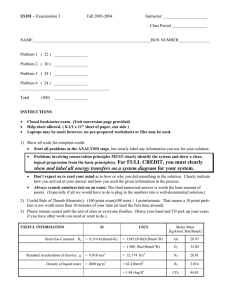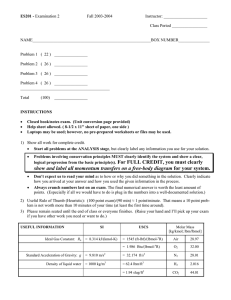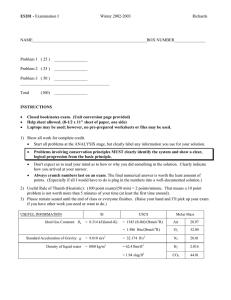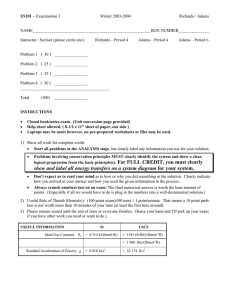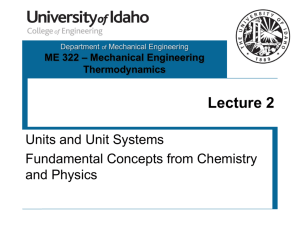ES201 - Winter 2002-2003 Richards
advertisement
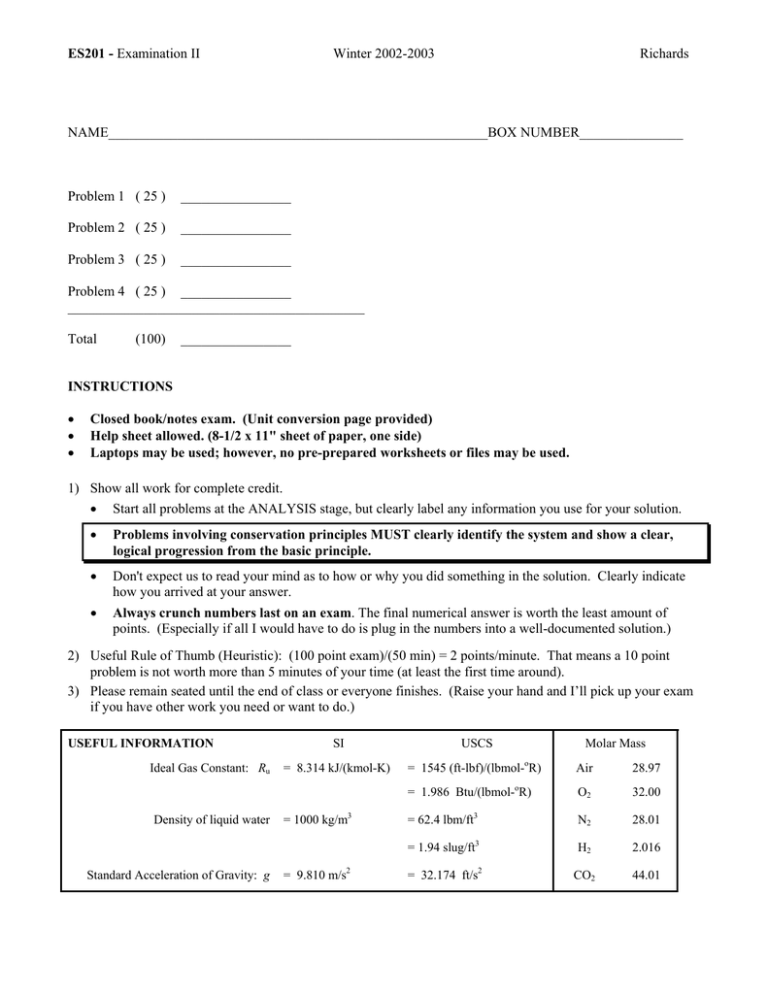
ES201 - Examination II Winter 2002-2003 Richards NAME_______________________________________________________BOX NUMBER_______________ Problem 1 ( 25 ) ________________ Problem 2 ( 25 ) ________________ Problem 3 ( 25 ) ________________ Problem 4 ( 25 ) ________________ ___________________________________________ Total (100) ________________ INSTRUCTIONS • • • Closed book/notes exam. (Unit conversion page provided) Help sheet allowed. (8-1/2 x 11" sheet of paper, one side) Laptops may be used; however, no pre-prepared worksheets or files may be used. 1) Show all work for complete credit. • Start all problems at the ANALYSIS stage, but clearly label any information you use for your solution. • Problems involving conservation principles MUST clearly identify the system and show a clear, logical progression from the basic principle. • Don't expect us to read your mind as to how or why you did something in the solution. Clearly indicate how you arrived at your answer. Always crunch numbers last on an exam. The final numerical answer is worth the least amount of points. (Especially if all I would have to do is plug in the numbers into a well-documented solution.) • 2) Useful Rule of Thumb (Heuristic): (100 point exam)/(50 min) = 2 points/minute. That means a 10 point problem is not worth more than 5 minutes of your time (at least the first time around). 3) Please remain seated until the end of class or everyone finishes. (Raise your hand and I’ll pick up your exam if you have other work you need or want to do.) USEFUL INFORMATION Ideal Gas Constant: Ru Density of liquid water Standard Acceleration of Gravity: g SI USCS = 8.314 kJ/(kmol-K) = 1545 (ft-lbf)/(lbmol-oR) Air 28.97 = 1.986 Btu/(lbmol-oR) O2 32.00 = 62.4 lbm/ft3 N2 28.01 = 1.94 slug/ft3 H2 2.016 = 32.174 ft/s2 CO2 44.01 = 1000 kg/m3 = 9.810 m/s2 Molar Mass Length Force 1 ft = 12 in = 0.3048 m = 1/3 yd 1 N = 1 kg·m/s2 = 0.22481 lbf 1 m = 100 cm 1 lbf = 1 slug·ft/s2 = 32.174 lbm·ft/s2 = 4.4482 N = 1000 mm = 39.37 in = 3.2808 ft 1 mile = 5280 ft = 1609.3 m Mass Pressure 1 atm = 101.325 kPa = 1.01325 bar = 14.696 lbf/in2 1 kg = 1000 g = 2.2046 lbm 1 bar = 100 kPa = 105 Pa 1 lbm = 16 oz = 0.45359 kg 1 Pa = 1 N/m2 = 10-3 kPa 1 slug = 32.174 lbm 1 lbf/in2 = 6.8947 kPa = 6894.7 N/m2 Temperature Values (T/K) = (T/ oR) / 1.8 (T/K) = (T/ oC) + 273.15 (T/oC) = [ (T/ oF) − 32 ]/1.8 (T/oR) = 1.8(T/K) (T/oR) = (T/ oF) + 459.67 (T/ oF) = 1.8(T/ oC) + 32 Temperature Differences o (∆T/ R) = 1.8(∆T / K) o o (∆T/ R) = (∆T/ F) (∆T / K) = (∆T/ o C) Volume [lbf/in2 often abbreviated as “psi” ] Energy 1 J = 1 N·m 1 kJ = 1000 J = 737.56 ft·lbf = 0.94782 Btu 1 Btu = 1.0551 kJ = 778.17 ft·lbf 1 ft·lbf = 1.3558 J Energy Transfer Rate 1 kW = 1 kJ/s = 737.56 ft·lbf/s = 1.3410 hp = 0.94782 Btu/s 1 Btu/s = 1.0551 kW = 1.4149 hp = 778.17 ft·lbf/s 1 hp = 550 ft·lbf/s = 0.74571 kW = 0.70679 Btu/s Specific Energy 1 kJ/kg = 1000 m2/s2 1 m3 = 1000 L = 106 cm3 = 106 mL = 35.315 ft3 = 264.17 gal 1 Btu/lbm = 25037 ft2/s2 1 ft3 = 1728 in3 = 7.4805 gal = 0.028317 m3 1 ft⋅lbf /lbm = 32.174 ft2/s2 1 gal = 0.13368 ft3 = 0.0037854 m3 Volumetric Flow Rate 1 m3/s = 35.315 ft3/s = 264.17 gal/s 1 ft3/s = 1.6990 m3/min = 7.4805 gal/s = 448.83 gal/min Problem 3 (25 points) The girder shown in the figure weighs 4000 N and the motor weighs 1200 N. The motor is hoisting a load that weighs 8000 N. (Assume mass moment of inertia of the motor Imotor is negligible.) Determine the reactions at A and B if the motor is raising the load and the load has an acceleration of 1.5 m/s upward. 8m 6m Motor A B 6.15 m Load Problem 2 (25 Points) A jet engine with exhaust nozzle is mounted on a test stand as shown in the figure. The engine is mounted as shown on two hangars and a diagonal brace. All connections are with frictionless pinned joints. Information about the flow area, pressure, and air velocity at three locations along the engine are given in the table. At steady-state operation, air is sucked into the inlet at the rate of 30 kg/s. Determine the direction and the magnitude of the force T in the diagonal brace. Is the brace in tension or compression? 1m Sec. 1 2 Sec. 2 Sec. 3 1m Flow area m 0.15 0.16 0.06 Pressure kPa 84 240 114 Air velocity m/s 120 315 600 60o 60o T 1 2 3 Problem 4 (25 points) A truck is traveling down a long steady grade (θ = 15o) as shown in the figure. The crate has mass mCrate = 500 kg with height H = 1 m and length L = 2 m. The crate rests on the trailer bed and the surface has a static friction coefficient µ S = 0.4 and a kinetic friction coefficient µ K = 0.3. To prevent the load from shifting, the driver must limit his braking. Determine the maximum truck deceleration if the crate does not slide on the trailer bed. FULL CREDIT will be given if you develop a sufficient set of simplified equations that can be solved to find the deceleration. YOU DO NOT NEED TO SOLVE THE EQUATIONS; however, you must clearly indicate which equations can be solved for the desired information. mCrate = 500 kg L=2m H=1m θ = 15o Problem 1 (25 points) A bullet strikes and glances off a flat plate as shown in the figure. The plate is resting on a frictionless horizontal surface. Initially, the bullet has a velocity of 800 ft/s and the plate is stationary. After striking the plate, the bullet velocity is 600 ft/s. Determine the final velocity of the plate. mBullet = 0.05 lbm mPlate = 3 lbm 30o 15o
